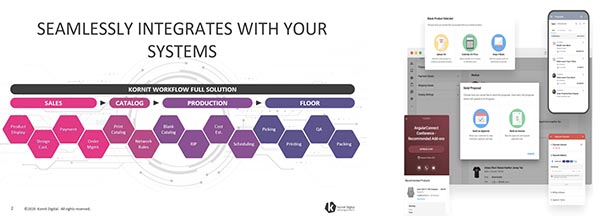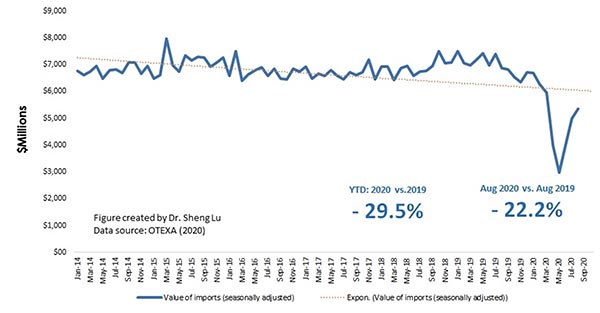DTG is Stronger than Ever Despite a Global Pandemic
COVID-19 was responsible for a boom in ecommerce and increased demand for digitally printed clothing. This article provides a brief overview of the changing consumer buying habits and explores why digital print on demand has accelerated. It also considers how GTM and supply chain strategies will change forever.
- COVID-19 accelerated brick and mortar store closures in a period when they were already commonplace. Many of these stores won’t reopen after lifting restrictions.
- The web-to print and workflow automation technologies allow consumers to create their own designs by allowing them to personalize garments as never before.
- 2020 direct-to-garment print volumes exceeded those from 2019, fueled by unprecedented increases in ecommerce sales—primarily in North America.
- In a post-pandemic world, retailers and manufacturers will increasingly rely on direct to-garment technologies for product design, trend analysis and real-time graphics testing.
By Mike Bertini
Introduction
Do you remember how life was before COVID-19 Sometimes it’s hard to recall what things were like before we had to worry about facemasks, social distancing, or transforming our homes into virtual workspaces. In the last 14 months, so much has changed. This includes how we shop for imprinted apparel and activewear. Many turned to the Internet to search for the latest trends in fashion and graphics after stores were placed under lockdown and had to shut down temporarily. The virtual marketplace offers a wide range of products and customization options. They no longer had to limit themselves to the space of a physical storefront. There were unlimited options available.
Consumers weren’t the only ones who quickly learned to adapt. As off-shore orders were cancelled or delayed, manufacturers and retailers had to rethink their supply chain and go-to market strategies. This left them with few products to sell. JIT manufacturing became essential as small runs of digitally printed products could be manufactured in local factories. Direct-to garment (DTG) was a way to produce on-demand, but also an efficient tool for trend analysis and graphics testing.
As a result, print service providers (PSPs) experienced unexpectedly high order volumes, leading to increased demand for new devices in the second half of 2020—particularly in North America. This was good news for OEMs since most of them ended 2020 with year-over–year gains despite this pandemic.
The Dynamic of Choice
It wasn’t long ago that limited choices dominated the decorated apparel landscape. The goal of brands was to predict future trends and have little stock left at the end of each season. In today’s marketplace, though, digital printing technologies enable consumers to create and personalize their apparel with the help of online web-to-print solutions. DTG has empowered consumers to create personalized graphics and products that were once out of reach—a paradigm shift that will forever change the dynamics of how decorated apparel is purchased. After all, who doesn’t like more choices? As consumers become their own designers, purchasing power is being transferred from the hands the few to the many.
OEMs are seizing this opportunity and focusing more resources in prepress and postpress solutions to enable PSPs become fully automated microfactories capable of printing garments as well as managing order processing and fulfillment. Kornit’s acquisition of Custom Gateway, a cloud-based workflow solution for digital PSPs, garnered attention in 2020 and uncovered the need for workflow solutions that enable consumers to customize their decorated apparel, while simultaneously sending the order processing and print jobs directly to press. Wasatch software has been partnered by Epson to automate workflows. This integration allows for file processing, barcoding and scanning on-press. InkSoft and third-party ecommerce platforms are making waves in the decorated clothing industry. Digital printing will continue to grow in popularity as consumers demand more customization and choice.

Solutions from Kornit/Custom Gateway, left, and InkSoft, right
The Pandemic and How It Changed Everything
Prior to COVID-19 -commerce was steadily reducing brick-and mortar sales. Store closures were commonplace as mom-and-pop boutiques—and even major retailers—struggled to survive, even in a booming economy. The pandemic sent this trend into overdrive as most remaining stores were forced to close for months at a time—and many of these will not reopen even after all restrictions are lifted. As a result, ecommerce sales grew at unprecedented levels, achieving a staggering 10 years’ worth of growth during a 90-day period.

Ecommerce growth
Source: The Reinvention of Retail; McKinsey & Company 2020
As consumers experienced the convenience, fast shipping, and seemingly endless array of products at their fingertips, they became hooked—if they weren’t already. The DTG market saw sales rise as PSPs and retailers marketed DTG on-demand graphics in a variety of colors and garments. Initial forecasts for 2020 of a 17% decrease in DTG print volumes compared with 2019 were made at the beginning of COVID-19. Thanks to accelerated ecommerce and digital print on-demand expansion, however, 2020 outpaced 2019 by about 5% as the second half of the year exploded—and the lion’s share of this occurred in North America. The DTG printing revolution is gaining momentum with a forecasted 13% compound annual growth rate (CAGR) from 2019–2024. DTG devices generated an estimated 823 million impressions in 2020. They are predicted to generate over 1.4 billion impressions by 2024.

DTG printed garments—global volume forecast
Source: DTG Market Forecast 2019-2024; Keypoint Intelligence 2020
Strategies for a new future
As the world looks forward to a post-pandemic future, it’s helpful to reflect on lessons learned from the past. COVID-19’s effects were a stark reminder about how fragile our supply chains are. Global trade and investment suffered as China, the US and Europe experienced declines of up to 50%. Purchase orders were cancelled and delayed as factories closed down. The normal flow of goods, which was largely driven by a single source cost-driven model, was disrupted and US apparel imports dropped.

US apparel imports from other countries (by value)
Source: https://shenglufashion.com
This forced companies to rethink the way they source products and encouraged many to diversify their supply chains. Digital printing technology allowed retailers and brands to create a buy-activated manufacturing model by domestically printing. The process taught them that DTG is not just for on-demand printing. Traditional buying seasons are being lost in an environment where speed to market is crucial and customers expect new products weekly. Brands and retailers can have both the best and worst of both worlds with digital print-on-demand. This allows them to offer new graphics online, and after identifying the top sellers, they can also opt for analog print inventory at lower costs.
DTG is changing the way product development looks in digital age. Retailers live and die by inventory management, and DTG is perhaps the most revolutionary tool for real-time trend analysis and graphics testing—with virtually no finished inventory risk. DTG technology has been a huge success for brands like Life Is Good. Hot Topic and other retailers are now using DTG to sell online, replenish store shelves, and fulfill immediate out-of stock orders. As we move into the second quarter of 2021, more brands and retailers will be using DTG.
The Bottom Line
DTG is more powerful than ever as it looks towards the future and is well-positioned for growth. Digital printing has revolutionized the way that decorated apparel is bought. This revolution was fueled by ecommerce growth and store closings. Consumers can personalize their items with web-to-print technology. OEMs will continue to invest in workflow automation so that PSPs are well-equipped for the transition. Retailers and brands have found a silver lining amid the dark cloud of a pandemic that has engulfed the world for more than a year. They had to rethink their supply chains and discovered that DTG can not only fulfill the need for on-demand printing but also serve as a tool for trend analysis, graphics testing, and graphics testing. DTG is still in its infancy, and it will be exciting to see how it continues to evolve—so stay tuned!
Mike Bertini is the Director of Textile and Direct-to-Garment/Direct-to-Fabric Printing at Keypoint Intelligence. His responsibilities include market research and forecasting, custom consultancy, strategy/planning engagements and the creation of editorial content and reports about digital textile printing. Prior to joining Keypoint Intelligence, Bertini served as Senior Product Manager, DTG at Life Is Good Clothing Co. His accomplishments at Life Is Good include spearheading a new textile digital printing facility including budget, layout, process flow, P&L, ERP implementation, and quality assurance standards.